GCC Milling Industry: Leadership, Sustainability, Lean, Agile, Leagile
VerifiedAdded on 2023/01/19
|28
|9463
|41
Thesis and Dissertation
AI Summary
This dissertation investigates the synergies between lean manufacturing practices, agile organizations, and their impact on sustainability, specifically within the milling industry in the GCC region. The research explores the challenges faced by contemporary organizations, including economic instability and the need for rapid adaptation to changing customer demands. The study examines the implementation of lean and agile methodologies, including the concept of 'Leagile' organizing, to determine their effectiveness in achieving both productivity and sustainability. The dissertation includes an overview of lean manufacturing, agile manufacturing, and Leagile manufacturing, along with their enablers and capabilities. The research also addresses the importance of organizational culture and adaptability in the adoption of agile methods. The study aims to determine whether Leagile is the most strategic way forward for companies in the milling industry, with a focus on immediate and sustainable impact, and recommendations for future research.
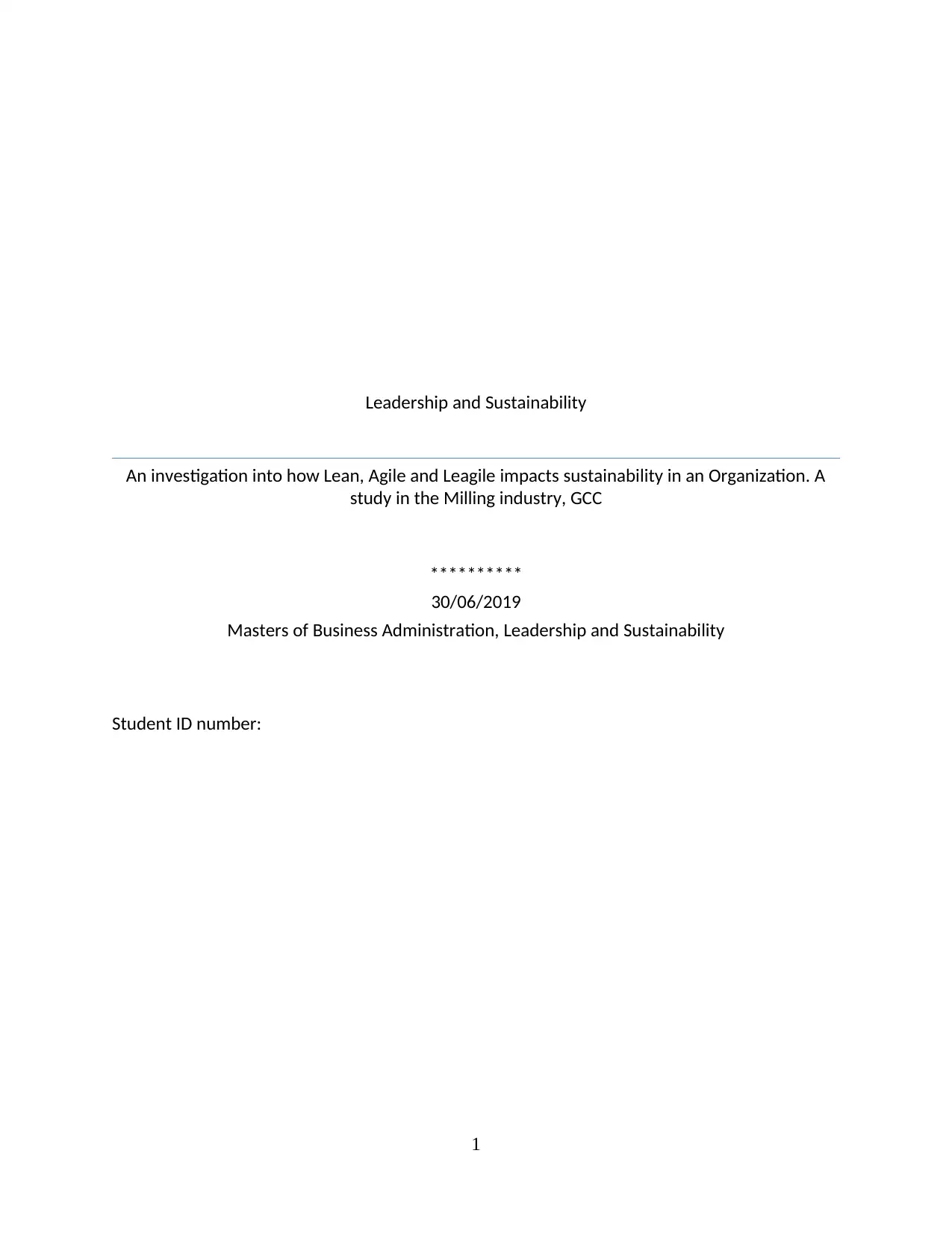
Leadership and Sustainability
An investigation into how Lean, Agile and Leagile impacts sustainability in an Organization. A
study in the Milling industry, GCC
**********
30/06/2019
Masters of Business Administration, Leadership and Sustainability
Student ID number:
1
An investigation into how Lean, Agile and Leagile impacts sustainability in an Organization. A
study in the Milling industry, GCC
**********
30/06/2019
Masters of Business Administration, Leadership and Sustainability
Student ID number:
1
Paraphrase This Document
Need a fresh take? Get an instant paraphrase of this document with our AI Paraphraser
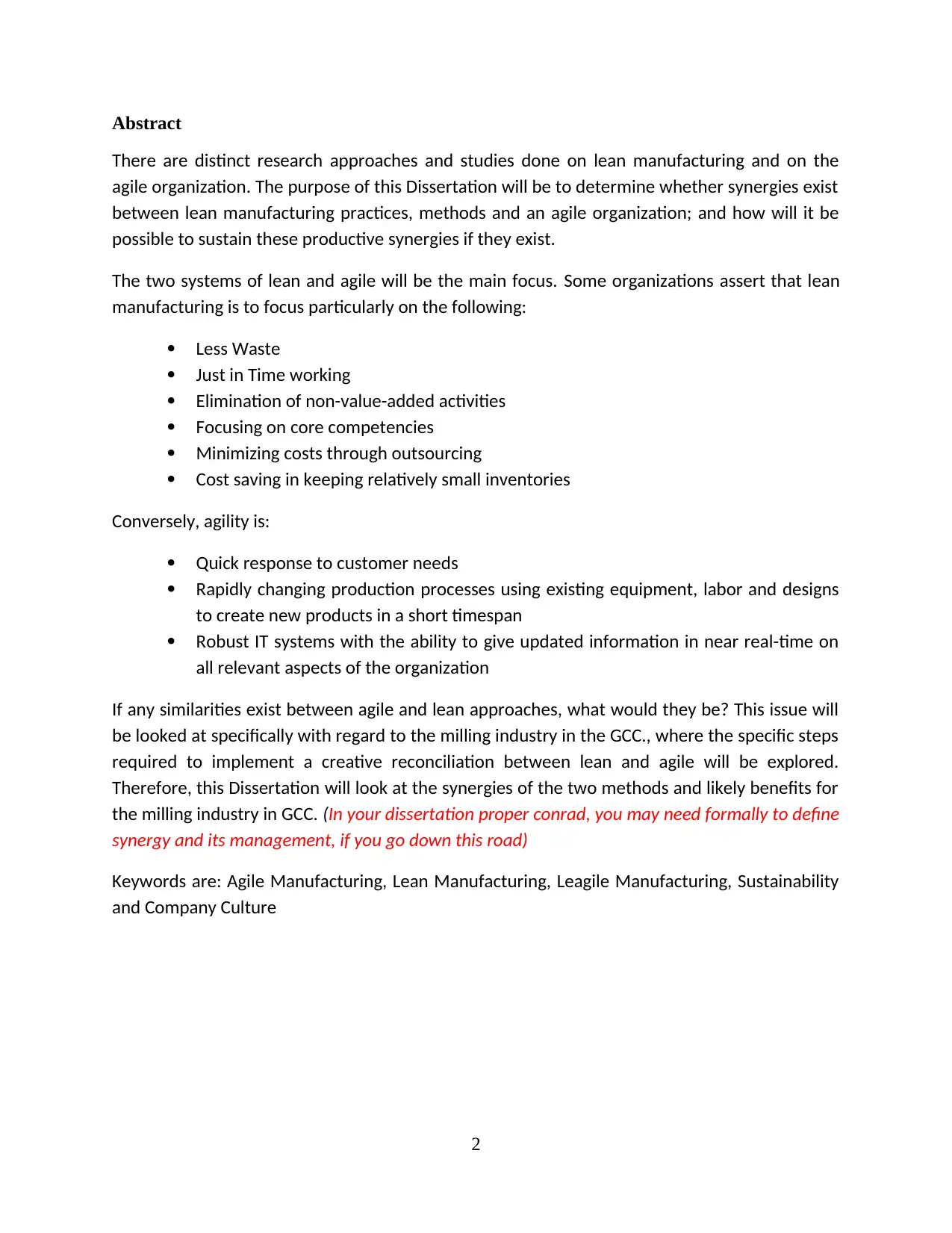
Abstract
There are distinct research approaches and studies done on lean manufacturing and on the
agile organization. The purpose of this Dissertation will be to determine whether synergies exist
between lean manufacturing practices, methods and an agile organization; and how will it be
possible to sustain these productive synergies if they exist.
The two systems of lean and agile will be the main focus. Some organizations assert that lean
manufacturing is to focus particularly on the following:
Less Waste
Just in Time working
Elimination of non-value-added activities
Focusing on core competencies
Minimizing costs through outsourcing
Cost saving in keeping relatively small inventories
Conversely, agility is:
Quick response to customer needs
Rapidly changing production processes using existing equipment, labor and designs
to create new products in a short timespan
Robust IT systems with the ability to give updated information in near real-time on
all relevant aspects of the organization
If any similarities exist between agile and lean approaches, what would they be? This issue will
be looked at specifically with regard to the milling industry in the GCC., where the specific steps
required to implement a creative reconciliation between lean and agile will be explored.
Therefore, this Dissertation will look at the synergies of the two methods and likely benefits for
the milling industry in GCC. (In your dissertation proper conrad, you may need formally to define
synergy and its management, if you go down this road)
Keywords are: Agile Manufacturing, Lean Manufacturing, Leagile Manufacturing, Sustainability
and Company Culture
2
There are distinct research approaches and studies done on lean manufacturing and on the
agile organization. The purpose of this Dissertation will be to determine whether synergies exist
between lean manufacturing practices, methods and an agile organization; and how will it be
possible to sustain these productive synergies if they exist.
The two systems of lean and agile will be the main focus. Some organizations assert that lean
manufacturing is to focus particularly on the following:
Less Waste
Just in Time working
Elimination of non-value-added activities
Focusing on core competencies
Minimizing costs through outsourcing
Cost saving in keeping relatively small inventories
Conversely, agility is:
Quick response to customer needs
Rapidly changing production processes using existing equipment, labor and designs
to create new products in a short timespan
Robust IT systems with the ability to give updated information in near real-time on
all relevant aspects of the organization
If any similarities exist between agile and lean approaches, what would they be? This issue will
be looked at specifically with regard to the milling industry in the GCC., where the specific steps
required to implement a creative reconciliation between lean and agile will be explored.
Therefore, this Dissertation will look at the synergies of the two methods and likely benefits for
the milling industry in GCC. (In your dissertation proper conrad, you may need formally to define
synergy and its management, if you go down this road)
Keywords are: Agile Manufacturing, Lean Manufacturing, Leagile Manufacturing, Sustainability
and Company Culture
2
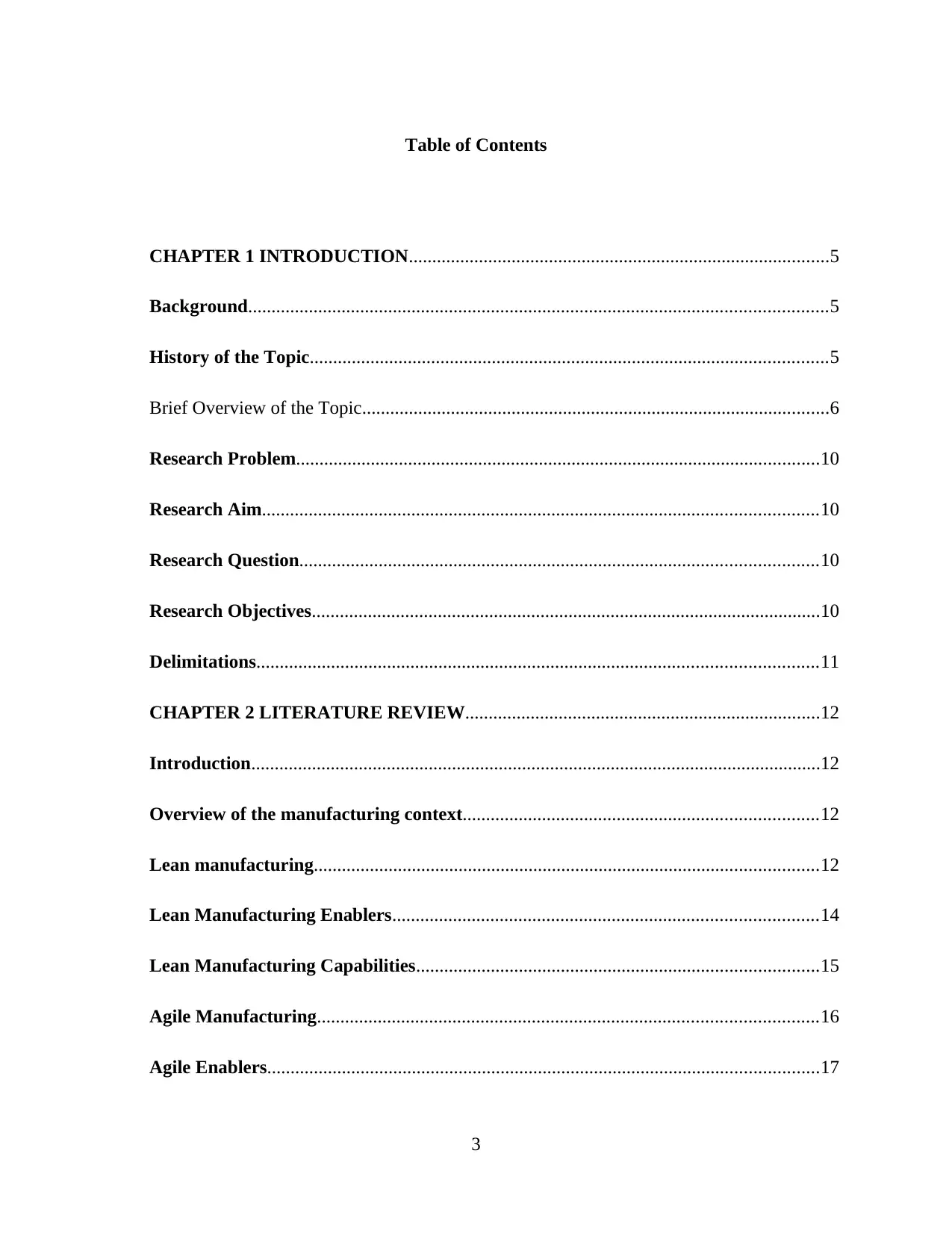
Table of Contents
CHAPTER 1 INTRODUCTION..........................................................................................5
Background............................................................................................................................5
History of the Topic...............................................................................................................5
Brief Overview of the Topic....................................................................................................6
Research Problem................................................................................................................10
Research Aim.......................................................................................................................10
Research Question...............................................................................................................10
Research Objectives.............................................................................................................10
Delimitations........................................................................................................................11
CHAPTER 2 LITERATURE REVIEW............................................................................12
Introduction..........................................................................................................................12
Overview of the manufacturing context............................................................................12
Lean manufacturing............................................................................................................12
Lean Manufacturing Enablers...........................................................................................14
Lean Manufacturing Capabilities......................................................................................15
Agile Manufacturing...........................................................................................................16
Agile Enablers......................................................................................................................17
3
CHAPTER 1 INTRODUCTION..........................................................................................5
Background............................................................................................................................5
History of the Topic...............................................................................................................5
Brief Overview of the Topic....................................................................................................6
Research Problem................................................................................................................10
Research Aim.......................................................................................................................10
Research Question...............................................................................................................10
Research Objectives.............................................................................................................10
Delimitations........................................................................................................................11
CHAPTER 2 LITERATURE REVIEW............................................................................12
Introduction..........................................................................................................................12
Overview of the manufacturing context............................................................................12
Lean manufacturing............................................................................................................12
Lean Manufacturing Enablers...........................................................................................14
Lean Manufacturing Capabilities......................................................................................15
Agile Manufacturing...........................................................................................................16
Agile Enablers......................................................................................................................17
3
⊘ This is a preview!⊘
Do you want full access?
Subscribe today to unlock all pages.

Trusted by 1+ million students worldwide
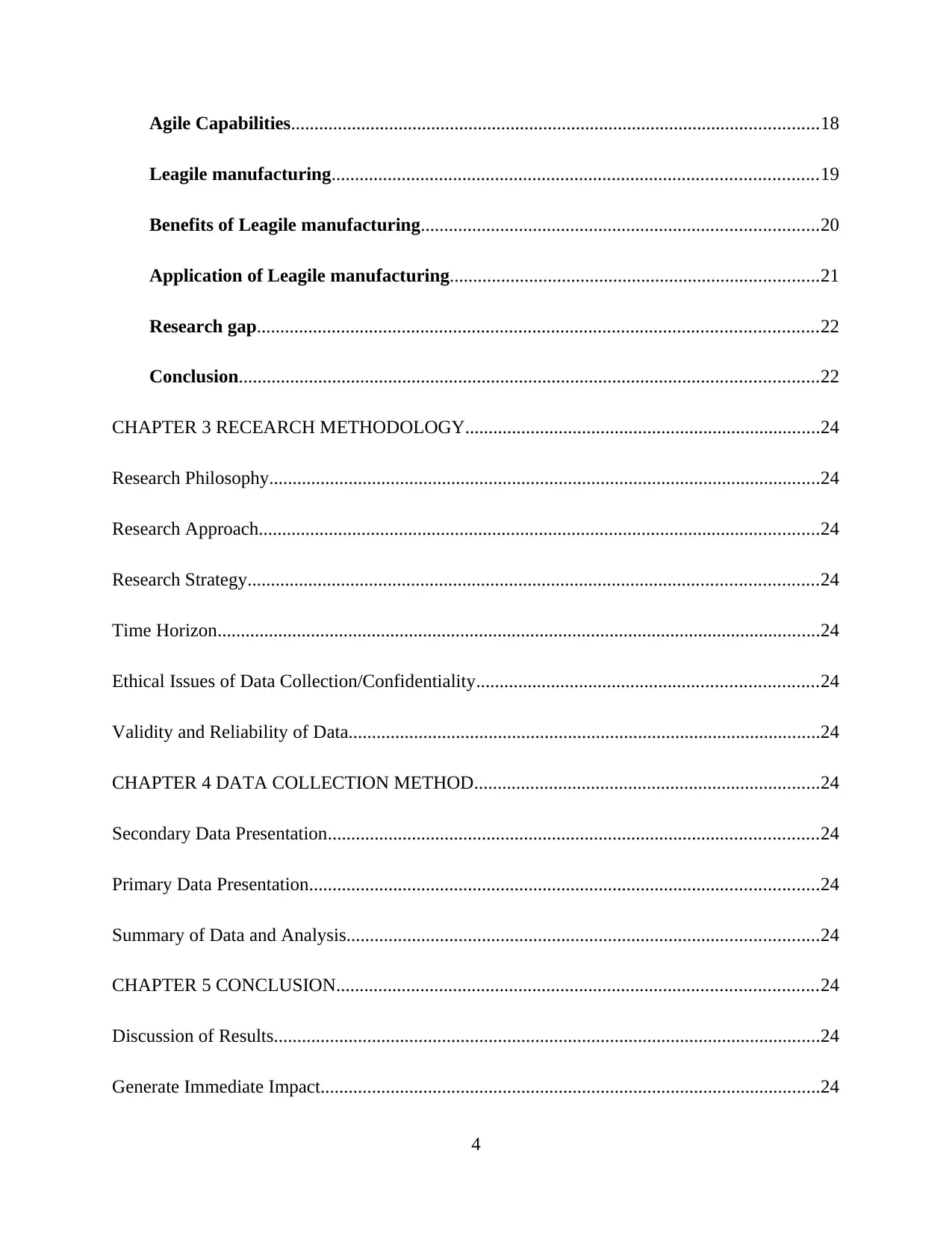
Agile Capabilities.................................................................................................................18
Leagile manufacturing........................................................................................................19
Benefits of Leagile manufacturing.....................................................................................20
Application of Leagile manufacturing...............................................................................21
Research gap........................................................................................................................22
Conclusion............................................................................................................................22
CHAPTER 3 RECEARCH METHODOLOGY............................................................................24
Research Philosophy......................................................................................................................24
Research Approach........................................................................................................................24
Research Strategy..........................................................................................................................24
Time Horizon.................................................................................................................................24
Ethical Issues of Data Collection/Confidentiality.........................................................................24
Validity and Reliability of Data.....................................................................................................24
CHAPTER 4 DATA COLLECTION METHOD..........................................................................24
Secondary Data Presentation.........................................................................................................24
Primary Data Presentation.............................................................................................................24
Summary of Data and Analysis.....................................................................................................24
CHAPTER 5 CONCLUSION.......................................................................................................24
Discussion of Results.....................................................................................................................24
Generate Immediate Impact...........................................................................................................24
4
Leagile manufacturing........................................................................................................19
Benefits of Leagile manufacturing.....................................................................................20
Application of Leagile manufacturing...............................................................................21
Research gap........................................................................................................................22
Conclusion............................................................................................................................22
CHAPTER 3 RECEARCH METHODOLOGY............................................................................24
Research Philosophy......................................................................................................................24
Research Approach........................................................................................................................24
Research Strategy..........................................................................................................................24
Time Horizon.................................................................................................................................24
Ethical Issues of Data Collection/Confidentiality.........................................................................24
Validity and Reliability of Data.....................................................................................................24
CHAPTER 4 DATA COLLECTION METHOD..........................................................................24
Secondary Data Presentation.........................................................................................................24
Primary Data Presentation.............................................................................................................24
Summary of Data and Analysis.....................................................................................................24
CHAPTER 5 CONCLUSION.......................................................................................................24
Discussion of Results.....................................................................................................................24
Generate Immediate Impact...........................................................................................................24
4
Paraphrase This Document
Need a fresh take? Get an instant paraphrase of this document with our AI Paraphraser
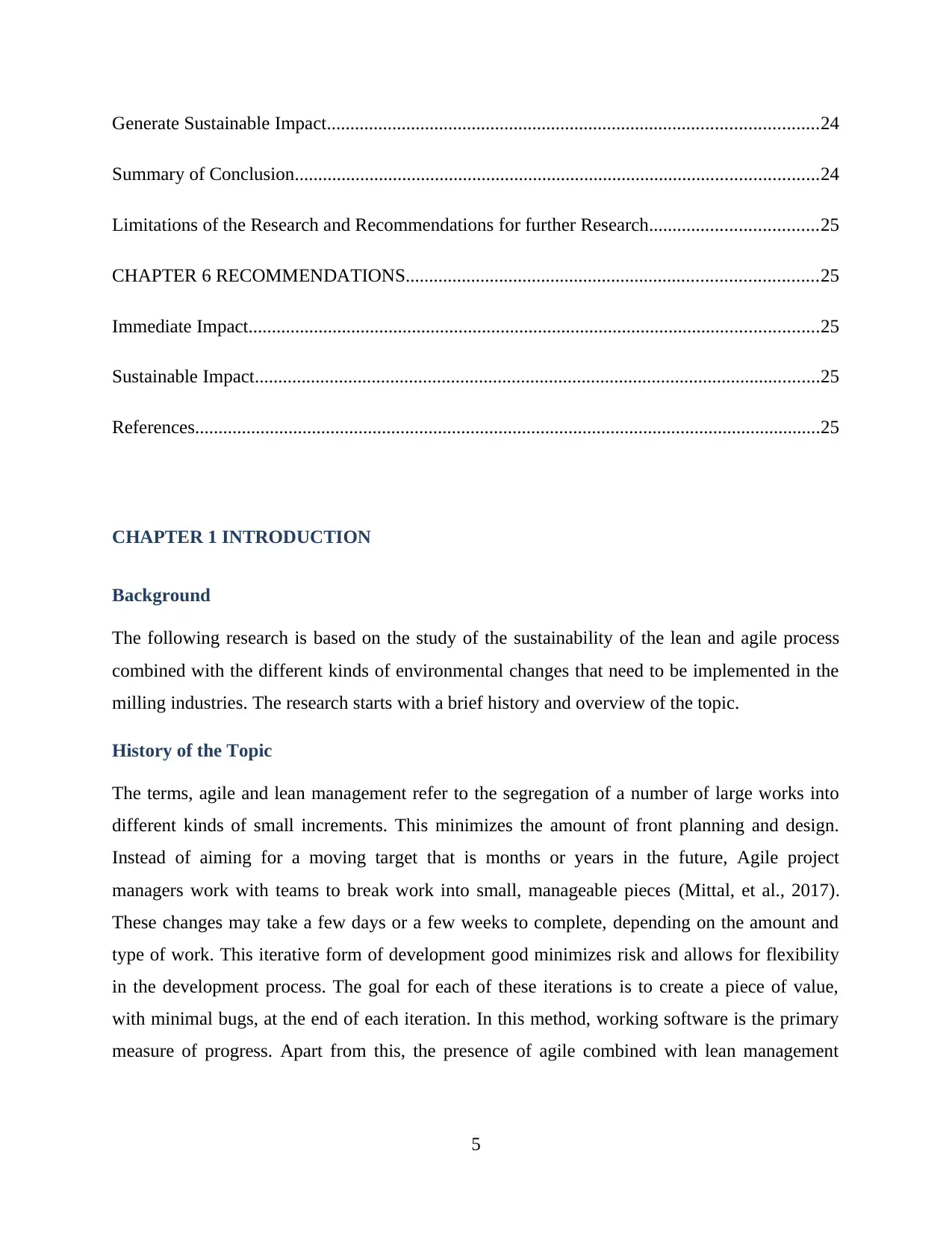
Generate Sustainable Impact.........................................................................................................24
Summary of Conclusion................................................................................................................24
Limitations of the Research and Recommendations for further Research....................................25
CHAPTER 6 RECOMMENDATIONS........................................................................................25
Immediate Impact..........................................................................................................................25
Sustainable Impact.........................................................................................................................25
References......................................................................................................................................25
CHAPTER 1 INTRODUCTION
Background
The following research is based on the study of the sustainability of the lean and agile process
combined with the different kinds of environmental changes that need to be implemented in the
milling industries. The research starts with a brief history and overview of the topic.
History of the Topic
The terms, agile and lean management refer to the segregation of a number of large works into
different kinds of small increments. This minimizes the amount of front planning and design.
Instead of aiming for a moving target that is months or years in the future, Agile project
managers work with teams to break work into small, manageable pieces (Mittal, et al., 2017).
These changes may take a few days or a few weeks to complete, depending on the amount and
type of work. This iterative form of development good minimizes risk and allows for flexibility
in the development process. The goal for each of these iterations is to create a piece of value,
with minimal bugs, at the end of each iteration. In this method, working software is the primary
measure of progress. Apart from this, the presence of agile combined with lean management
5
Summary of Conclusion................................................................................................................24
Limitations of the Research and Recommendations for further Research....................................25
CHAPTER 6 RECOMMENDATIONS........................................................................................25
Immediate Impact..........................................................................................................................25
Sustainable Impact.........................................................................................................................25
References......................................................................................................................................25
CHAPTER 1 INTRODUCTION
Background
The following research is based on the study of the sustainability of the lean and agile process
combined with the different kinds of environmental changes that need to be implemented in the
milling industries. The research starts with a brief history and overview of the topic.
History of the Topic
The terms, agile and lean management refer to the segregation of a number of large works into
different kinds of small increments. This minimizes the amount of front planning and design.
Instead of aiming for a moving target that is months or years in the future, Agile project
managers work with teams to break work into small, manageable pieces (Mittal, et al., 2017).
These changes may take a few days or a few weeks to complete, depending on the amount and
type of work. This iterative form of development good minimizes risk and allows for flexibility
in the development process. The goal for each of these iterations is to create a piece of value,
with minimal bugs, at the end of each iteration. In this method, working software is the primary
measure of progress. Apart from this, the presence of agile combined with lean management
5
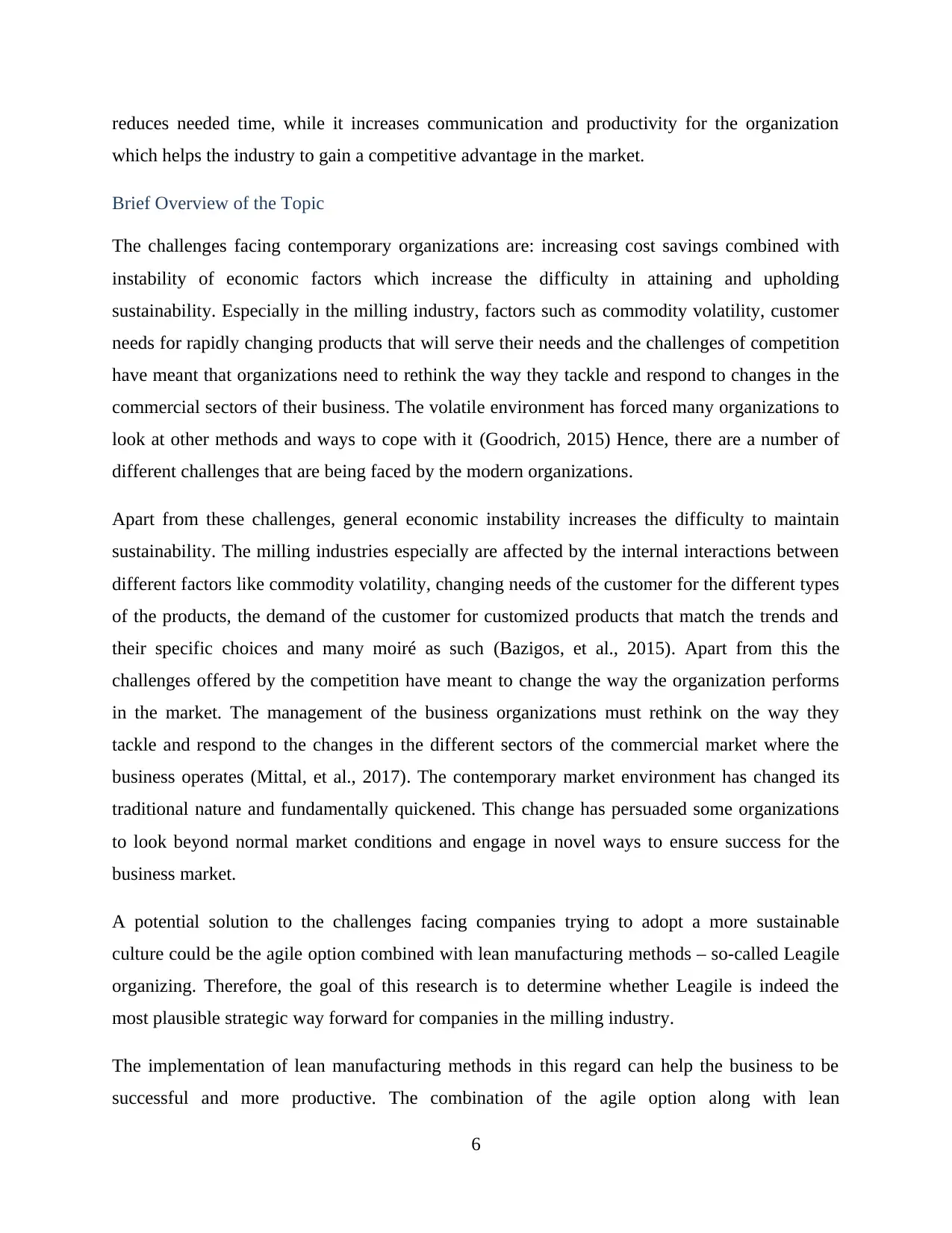
reduces needed time, while it increases communication and productivity for the organization
which helps the industry to gain a competitive advantage in the market.
Brief Overview of the Topic
The challenges facing contemporary organizations are: increasing cost savings combined with
instability of economic factors which increase the difficulty in attaining and upholding
sustainability. Especially in the milling industry, factors such as commodity volatility, customer
needs for rapidly changing products that will serve their needs and the challenges of competition
have meant that organizations need to rethink the way they tackle and respond to changes in the
commercial sectors of their business. The volatile environment has forced many organizations to
look at other methods and ways to cope with it (Goodrich, 2015) Hence, there are a number of
different challenges that are being faced by the modern organizations.
Apart from these challenges, general economic instability increases the difficulty to maintain
sustainability. The milling industries especially are affected by the internal interactions between
different factors like commodity volatility, changing needs of the customer for the different types
of the products, the demand of the customer for customized products that match the trends and
their specific choices and many moiré as such (Bazigos, et al., 2015). Apart from this the
challenges offered by the competition have meant to change the way the organization performs
in the market. The management of the business organizations must rethink on the way they
tackle and respond to the changes in the different sectors of the commercial market where the
business operates (Mittal, et al., 2017). The contemporary market environment has changed its
traditional nature and fundamentally quickened. This change has persuaded some organizations
to look beyond normal market conditions and engage in novel ways to ensure success for the
business market.
A potential solution to the challenges facing companies trying to adopt a more sustainable
culture could be the agile option combined with lean manufacturing methods – so-called Leagile
organizing. Therefore, the goal of this research is to determine whether Leagile is indeed the
most plausible strategic way forward for companies in the milling industry.
The implementation of lean manufacturing methods in this regard can help the business to be
successful and more productive. The combination of the agile option along with lean
6
which helps the industry to gain a competitive advantage in the market.
Brief Overview of the Topic
The challenges facing contemporary organizations are: increasing cost savings combined with
instability of economic factors which increase the difficulty in attaining and upholding
sustainability. Especially in the milling industry, factors such as commodity volatility, customer
needs for rapidly changing products that will serve their needs and the challenges of competition
have meant that organizations need to rethink the way they tackle and respond to changes in the
commercial sectors of their business. The volatile environment has forced many organizations to
look at other methods and ways to cope with it (Goodrich, 2015) Hence, there are a number of
different challenges that are being faced by the modern organizations.
Apart from these challenges, general economic instability increases the difficulty to maintain
sustainability. The milling industries especially are affected by the internal interactions between
different factors like commodity volatility, changing needs of the customer for the different types
of the products, the demand of the customer for customized products that match the trends and
their specific choices and many moiré as such (Bazigos, et al., 2015). Apart from this the
challenges offered by the competition have meant to change the way the organization performs
in the market. The management of the business organizations must rethink on the way they
tackle and respond to the changes in the different sectors of the commercial market where the
business operates (Mittal, et al., 2017). The contemporary market environment has changed its
traditional nature and fundamentally quickened. This change has persuaded some organizations
to look beyond normal market conditions and engage in novel ways to ensure success for the
business market.
A potential solution to the challenges facing companies trying to adopt a more sustainable
culture could be the agile option combined with lean manufacturing methods – so-called Leagile
organizing. Therefore, the goal of this research is to determine whether Leagile is indeed the
most plausible strategic way forward for companies in the milling industry.
The implementation of lean manufacturing methods in this regard can help the business to be
successful and more productive. The combination of the agile option along with lean
6
⊘ This is a preview!⊘
Do you want full access?
Subscribe today to unlock all pages.

Trusted by 1+ million students worldwide
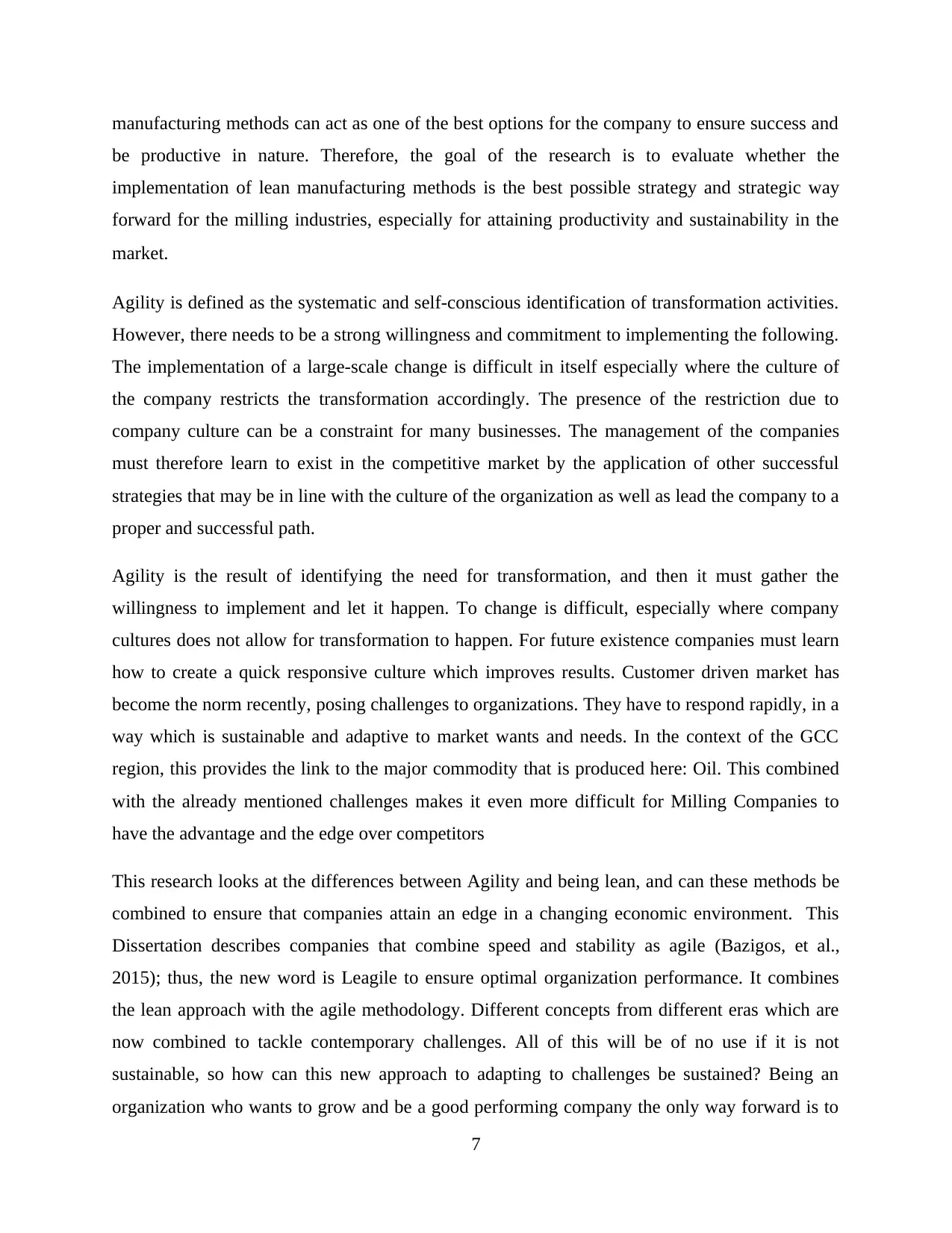
manufacturing methods can act as one of the best options for the company to ensure success and
be productive in nature. Therefore, the goal of the research is to evaluate whether the
implementation of lean manufacturing methods is the best possible strategy and strategic way
forward for the milling industries, especially for attaining productivity and sustainability in the
market.
Agility is defined as the systematic and self-conscious identification of transformation activities.
However, there needs to be a strong willingness and commitment to implementing the following.
The implementation of a large-scale change is difficult in itself especially where the culture of
the company restricts the transformation accordingly. The presence of the restriction due to
company culture can be a constraint for many businesses. The management of the companies
must therefore learn to exist in the competitive market by the application of other successful
strategies that may be in line with the culture of the organization as well as lead the company to a
proper and successful path.
Agility is the result of identifying the need for transformation, and then it must gather the
willingness to implement and let it happen. To change is difficult, especially where company
cultures does not allow for transformation to happen. For future existence companies must learn
how to create a quick responsive culture which improves results. Customer driven market has
become the norm recently, posing challenges to organizations. They have to respond rapidly, in a
way which is sustainable and adaptive to market wants and needs. In the context of the GCC
region, this provides the link to the major commodity that is produced here: Oil. This combined
with the already mentioned challenges makes it even more difficult for Milling Companies to
have the advantage and the edge over competitors
This research looks at the differences between Agility and being lean, and can these methods be
combined to ensure that companies attain an edge in a changing economic environment. This
Dissertation describes companies that combine speed and stability as agile (Bazigos, et al.,
2015); thus, the new word is Leagile to ensure optimal organization performance. It combines
the lean approach with the agile methodology. Different concepts from different eras which are
now combined to tackle contemporary challenges. All of this will be of no use if it is not
sustainable, so how can this new approach to adapting to challenges be sustained? Being an
organization who wants to grow and be a good performing company the only way forward is to
7
be productive in nature. Therefore, the goal of the research is to evaluate whether the
implementation of lean manufacturing methods is the best possible strategy and strategic way
forward for the milling industries, especially for attaining productivity and sustainability in the
market.
Agility is defined as the systematic and self-conscious identification of transformation activities.
However, there needs to be a strong willingness and commitment to implementing the following.
The implementation of a large-scale change is difficult in itself especially where the culture of
the company restricts the transformation accordingly. The presence of the restriction due to
company culture can be a constraint for many businesses. The management of the companies
must therefore learn to exist in the competitive market by the application of other successful
strategies that may be in line with the culture of the organization as well as lead the company to a
proper and successful path.
Agility is the result of identifying the need for transformation, and then it must gather the
willingness to implement and let it happen. To change is difficult, especially where company
cultures does not allow for transformation to happen. For future existence companies must learn
how to create a quick responsive culture which improves results. Customer driven market has
become the norm recently, posing challenges to organizations. They have to respond rapidly, in a
way which is sustainable and adaptive to market wants and needs. In the context of the GCC
region, this provides the link to the major commodity that is produced here: Oil. This combined
with the already mentioned challenges makes it even more difficult for Milling Companies to
have the advantage and the edge over competitors
This research looks at the differences between Agility and being lean, and can these methods be
combined to ensure that companies attain an edge in a changing economic environment. This
Dissertation describes companies that combine speed and stability as agile (Bazigos, et al.,
2015); thus, the new word is Leagile to ensure optimal organization performance. It combines
the lean approach with the agile methodology. Different concepts from different eras which are
now combined to tackle contemporary challenges. All of this will be of no use if it is not
sustainable, so how can this new approach to adapting to challenges be sustained? Being an
organization who wants to grow and be a good performing company the only way forward is to
7
Paraphrase This Document
Need a fresh take? Get an instant paraphrase of this document with our AI Paraphraser
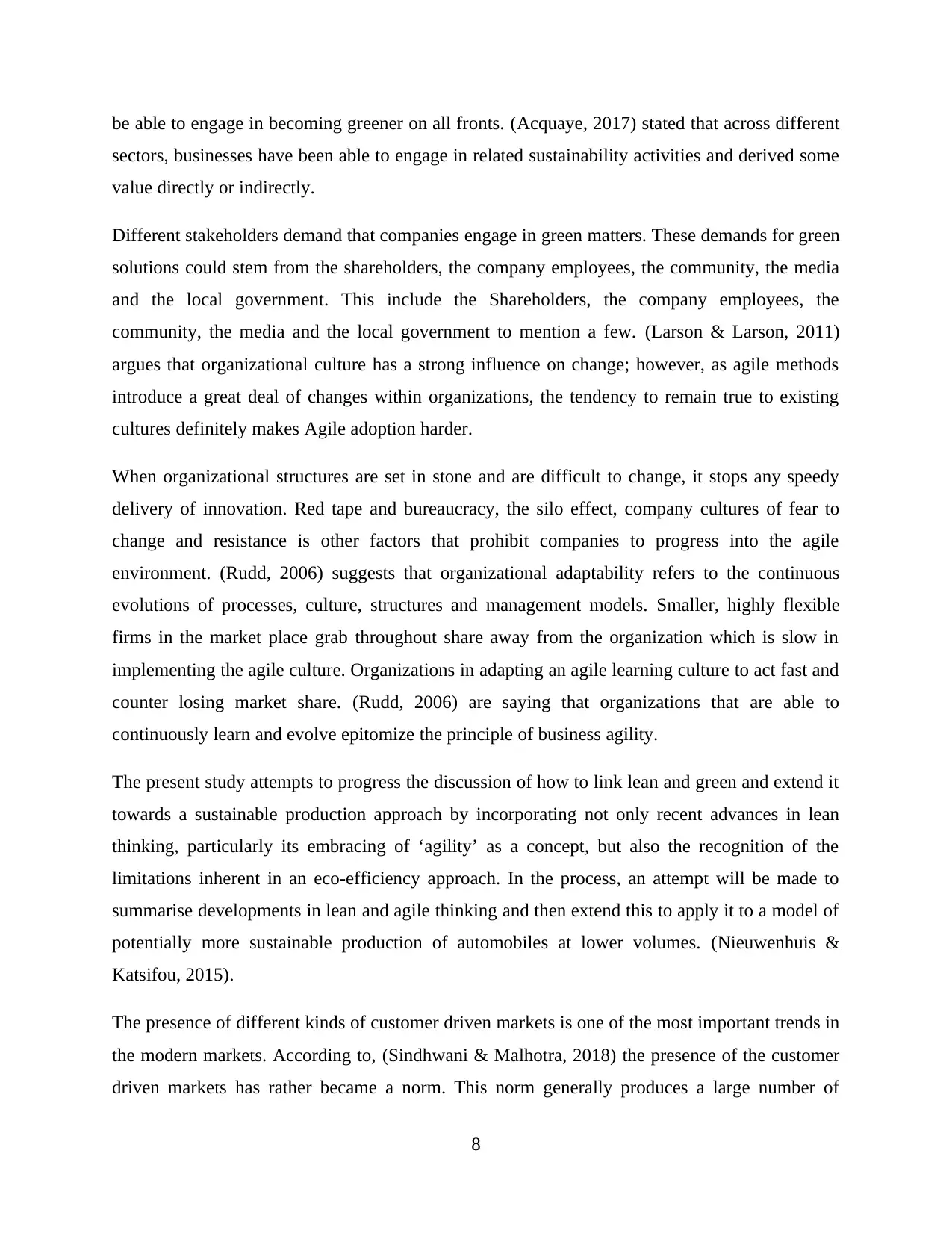
be able to engage in becoming greener on all fronts. (Acquaye, 2017) stated that across different
sectors, businesses have been able to engage in related sustainability activities and derived some
value directly or indirectly.
Different stakeholders demand that companies engage in green matters. These demands for green
solutions could stem from the shareholders, the company employees, the community, the media
and the local government. This include the Shareholders, the company employees, the
community, the media and the local government to mention a few. (Larson & Larson, 2011)
argues that organizational culture has a strong influence on change; however, as agile methods
introduce a great deal of changes within organizations, the tendency to remain true to existing
cultures definitely makes Agile adoption harder.
When organizational structures are set in stone and are difficult to change, it stops any speedy
delivery of innovation. Red tape and bureaucracy, the silo effect, company cultures of fear to
change and resistance is other factors that prohibit companies to progress into the agile
environment. (Rudd, 2006) suggests that organizational adaptability refers to the continuous
evolutions of processes, culture, structures and management models. Smaller, highly flexible
firms in the market place grab throughout share away from the organization which is slow in
implementing the agile culture. Organizations in adapting an agile learning culture to act fast and
counter losing market share. (Rudd, 2006) are saying that organizations that are able to
continuously learn and evolve epitomize the principle of business agility.
The present study attempts to progress the discussion of how to link lean and green and extend it
towards a sustainable production approach by incorporating not only recent advances in lean
thinking, particularly its embracing of ‘agility’ as a concept, but also the recognition of the
limitations inherent in an eco-efficiency approach. In the process, an attempt will be made to
summarise developments in lean and agile thinking and then extend this to apply it to a model of
potentially more sustainable production of automobiles at lower volumes. (Nieuwenhuis &
Katsifou, 2015).
The presence of different kinds of customer driven markets is one of the most important trends in
the modern markets. According to, (Sindhwani & Malhotra, 2018) the presence of the customer
driven markets has rather became a norm. This norm generally produces a large number of
8
sectors, businesses have been able to engage in related sustainability activities and derived some
value directly or indirectly.
Different stakeholders demand that companies engage in green matters. These demands for green
solutions could stem from the shareholders, the company employees, the community, the media
and the local government. This include the Shareholders, the company employees, the
community, the media and the local government to mention a few. (Larson & Larson, 2011)
argues that organizational culture has a strong influence on change; however, as agile methods
introduce a great deal of changes within organizations, the tendency to remain true to existing
cultures definitely makes Agile adoption harder.
When organizational structures are set in stone and are difficult to change, it stops any speedy
delivery of innovation. Red tape and bureaucracy, the silo effect, company cultures of fear to
change and resistance is other factors that prohibit companies to progress into the agile
environment. (Rudd, 2006) suggests that organizational adaptability refers to the continuous
evolutions of processes, culture, structures and management models. Smaller, highly flexible
firms in the market place grab throughout share away from the organization which is slow in
implementing the agile culture. Organizations in adapting an agile learning culture to act fast and
counter losing market share. (Rudd, 2006) are saying that organizations that are able to
continuously learn and evolve epitomize the principle of business agility.
The present study attempts to progress the discussion of how to link lean and green and extend it
towards a sustainable production approach by incorporating not only recent advances in lean
thinking, particularly its embracing of ‘agility’ as a concept, but also the recognition of the
limitations inherent in an eco-efficiency approach. In the process, an attempt will be made to
summarise developments in lean and agile thinking and then extend this to apply it to a model of
potentially more sustainable production of automobiles at lower volumes. (Nieuwenhuis &
Katsifou, 2015).
The presence of different kinds of customer driven markets is one of the most important trends in
the modern markets. According to, (Sindhwani & Malhotra, 2018) the presence of the customer
driven markets has rather became a norm. This norm generally produces a large number of
8
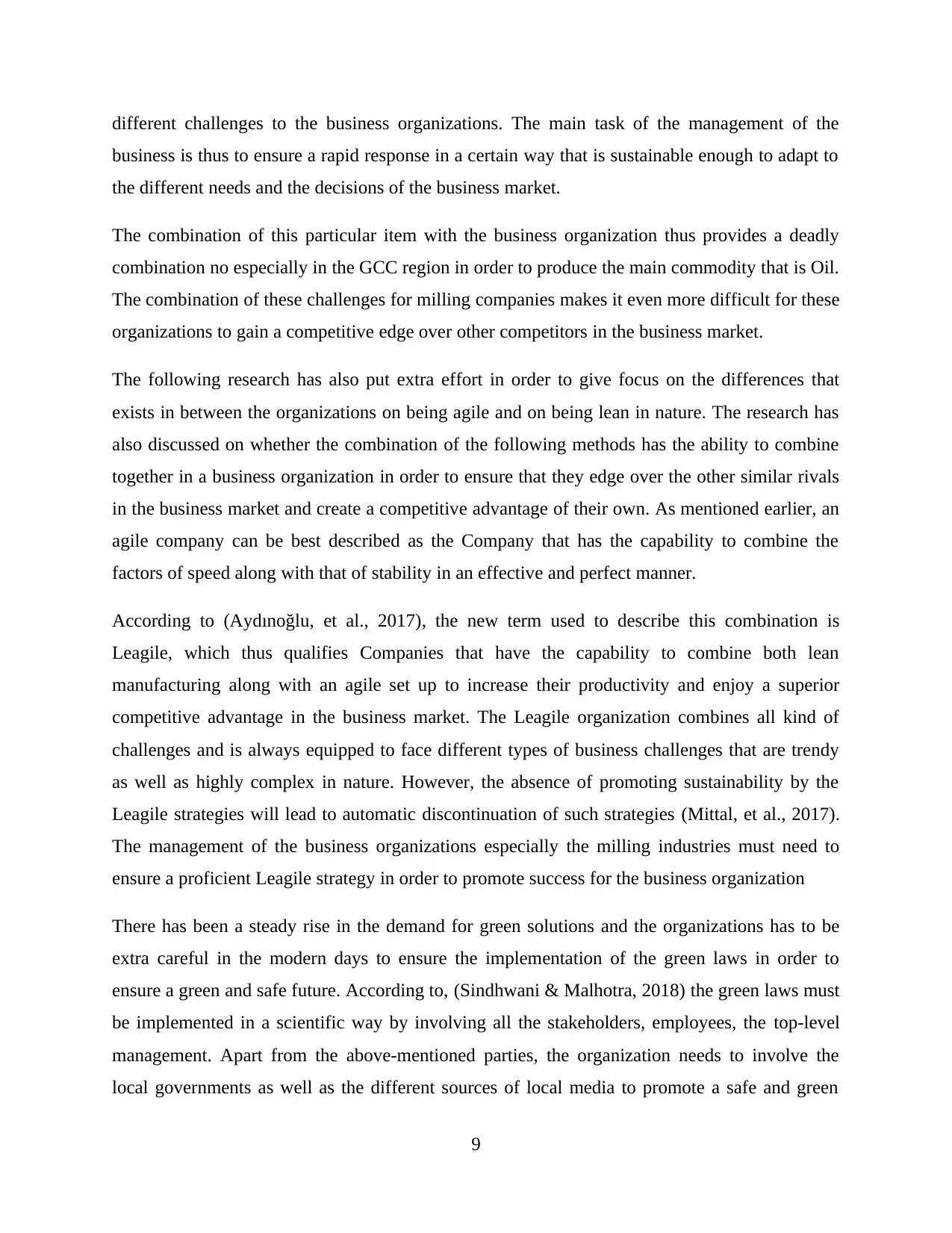
different challenges to the business organizations. The main task of the management of the
business is thus to ensure a rapid response in a certain way that is sustainable enough to adapt to
the different needs and the decisions of the business market.
The combination of this particular item with the business organization thus provides a deadly
combination no especially in the GCC region in order to produce the main commodity that is Oil.
The combination of these challenges for milling companies makes it even more difficult for these
organizations to gain a competitive edge over other competitors in the business market.
The following research has also put extra effort in order to give focus on the differences that
exists in between the organizations on being agile and on being lean in nature. The research has
also discussed on whether the combination of the following methods has the ability to combine
together in a business organization in order to ensure that they edge over the other similar rivals
in the business market and create a competitive advantage of their own. As mentioned earlier, an
agile company can be best described as the Company that has the capability to combine the
factors of speed along with that of stability in an effective and perfect manner.
According to (Aydınoğlu, et al., 2017), the new term used to describe this combination is
Leagile, which thus qualifies Companies that have the capability to combine both lean
manufacturing along with an agile set up to increase their productivity and enjoy a superior
competitive advantage in the business market. The Leagile organization combines all kind of
challenges and is always equipped to face different types of business challenges that are trendy
as well as highly complex in nature. However, the absence of promoting sustainability by the
Leagile strategies will lead to automatic discontinuation of such strategies (Mittal, et al., 2017).
The management of the business organizations especially the milling industries must need to
ensure a proficient Leagile strategy in order to promote success for the business organization
There has been a steady rise in the demand for green solutions and the organizations has to be
extra careful in the modern days to ensure the implementation of the green laws in order to
ensure a green and safe future. According to, (Sindhwani & Malhotra, 2018) the green laws must
be implemented in a scientific way by involving all the stakeholders, employees, the top-level
management. Apart from the above-mentioned parties, the organization needs to involve the
local governments as well as the different sources of local media to promote a safe and green
9
business is thus to ensure a rapid response in a certain way that is sustainable enough to adapt to
the different needs and the decisions of the business market.
The combination of this particular item with the business organization thus provides a deadly
combination no especially in the GCC region in order to produce the main commodity that is Oil.
The combination of these challenges for milling companies makes it even more difficult for these
organizations to gain a competitive edge over other competitors in the business market.
The following research has also put extra effort in order to give focus on the differences that
exists in between the organizations on being agile and on being lean in nature. The research has
also discussed on whether the combination of the following methods has the ability to combine
together in a business organization in order to ensure that they edge over the other similar rivals
in the business market and create a competitive advantage of their own. As mentioned earlier, an
agile company can be best described as the Company that has the capability to combine the
factors of speed along with that of stability in an effective and perfect manner.
According to (Aydınoğlu, et al., 2017), the new term used to describe this combination is
Leagile, which thus qualifies Companies that have the capability to combine both lean
manufacturing along with an agile set up to increase their productivity and enjoy a superior
competitive advantage in the business market. The Leagile organization combines all kind of
challenges and is always equipped to face different types of business challenges that are trendy
as well as highly complex in nature. However, the absence of promoting sustainability by the
Leagile strategies will lead to automatic discontinuation of such strategies (Mittal, et al., 2017).
The management of the business organizations especially the milling industries must need to
ensure a proficient Leagile strategy in order to promote success for the business organization
There has been a steady rise in the demand for green solutions and the organizations has to be
extra careful in the modern days to ensure the implementation of the green laws in order to
ensure a green and safe future. According to, (Sindhwani & Malhotra, 2018) the green laws must
be implemented in a scientific way by involving all the stakeholders, employees, the top-level
management. Apart from the above-mentioned parties, the organization needs to involve the
local governments as well as the different sources of local media to promote a safe and green
9
⊘ This is a preview!⊘
Do you want full access?
Subscribe today to unlock all pages.

Trusted by 1+ million students worldwide
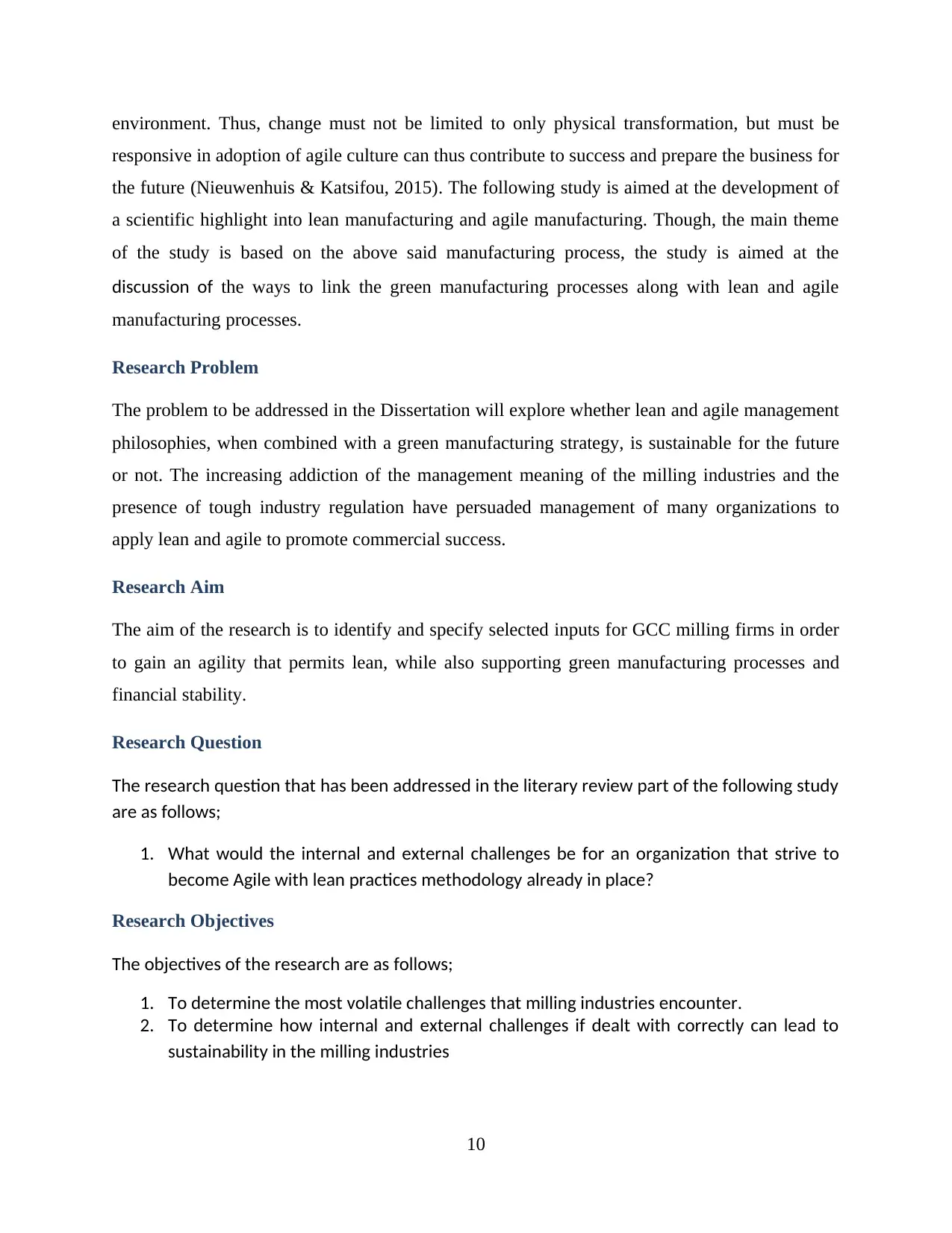
environment. Thus, change must not be limited to only physical transformation, but must be
responsive in adoption of agile culture can thus contribute to success and prepare the business for
the future (Nieuwenhuis & Katsifou, 2015). The following study is aimed at the development of
a scientific highlight into lean manufacturing and agile manufacturing. Though, the main theme
of the study is based on the above said manufacturing process, the study is aimed at the
discussion of the ways to link the green manufacturing processes along with lean and agile
manufacturing processes.
Research Problem
The problem to be addressed in the Dissertation will explore whether lean and agile management
philosophies, when combined with a green manufacturing strategy, is sustainable for the future
or not. The increasing addiction of the management meaning of the milling industries and the
presence of tough industry regulation have persuaded management of many organizations to
apply lean and agile to promote commercial success.
Research Aim
The aim of the research is to identify and specify selected inputs for GCC milling firms in order
to gain an agility that permits lean, while also supporting green manufacturing processes and
financial stability.
Research Question
The research question that has been addressed in the literary review part of the following study
are as follows;
1. What would the internal and external challenges be for an organization that strive to
become Agile with lean practices methodology already in place?
Research Objectives
The objectives of the research are as follows;
1. To determine the most volatile challenges that milling industries encounter.
2. To determine how internal and external challenges if dealt with correctly can lead to
sustainability in the milling industries
10
responsive in adoption of agile culture can thus contribute to success and prepare the business for
the future (Nieuwenhuis & Katsifou, 2015). The following study is aimed at the development of
a scientific highlight into lean manufacturing and agile manufacturing. Though, the main theme
of the study is based on the above said manufacturing process, the study is aimed at the
discussion of the ways to link the green manufacturing processes along with lean and agile
manufacturing processes.
Research Problem
The problem to be addressed in the Dissertation will explore whether lean and agile management
philosophies, when combined with a green manufacturing strategy, is sustainable for the future
or not. The increasing addiction of the management meaning of the milling industries and the
presence of tough industry regulation have persuaded management of many organizations to
apply lean and agile to promote commercial success.
Research Aim
The aim of the research is to identify and specify selected inputs for GCC milling firms in order
to gain an agility that permits lean, while also supporting green manufacturing processes and
financial stability.
Research Question
The research question that has been addressed in the literary review part of the following study
are as follows;
1. What would the internal and external challenges be for an organization that strive to
become Agile with lean practices methodology already in place?
Research Objectives
The objectives of the research are as follows;
1. To determine the most volatile challenges that milling industries encounter.
2. To determine how internal and external challenges if dealt with correctly can lead to
sustainability in the milling industries
10
Paraphrase This Document
Need a fresh take? Get an instant paraphrase of this document with our AI Paraphraser
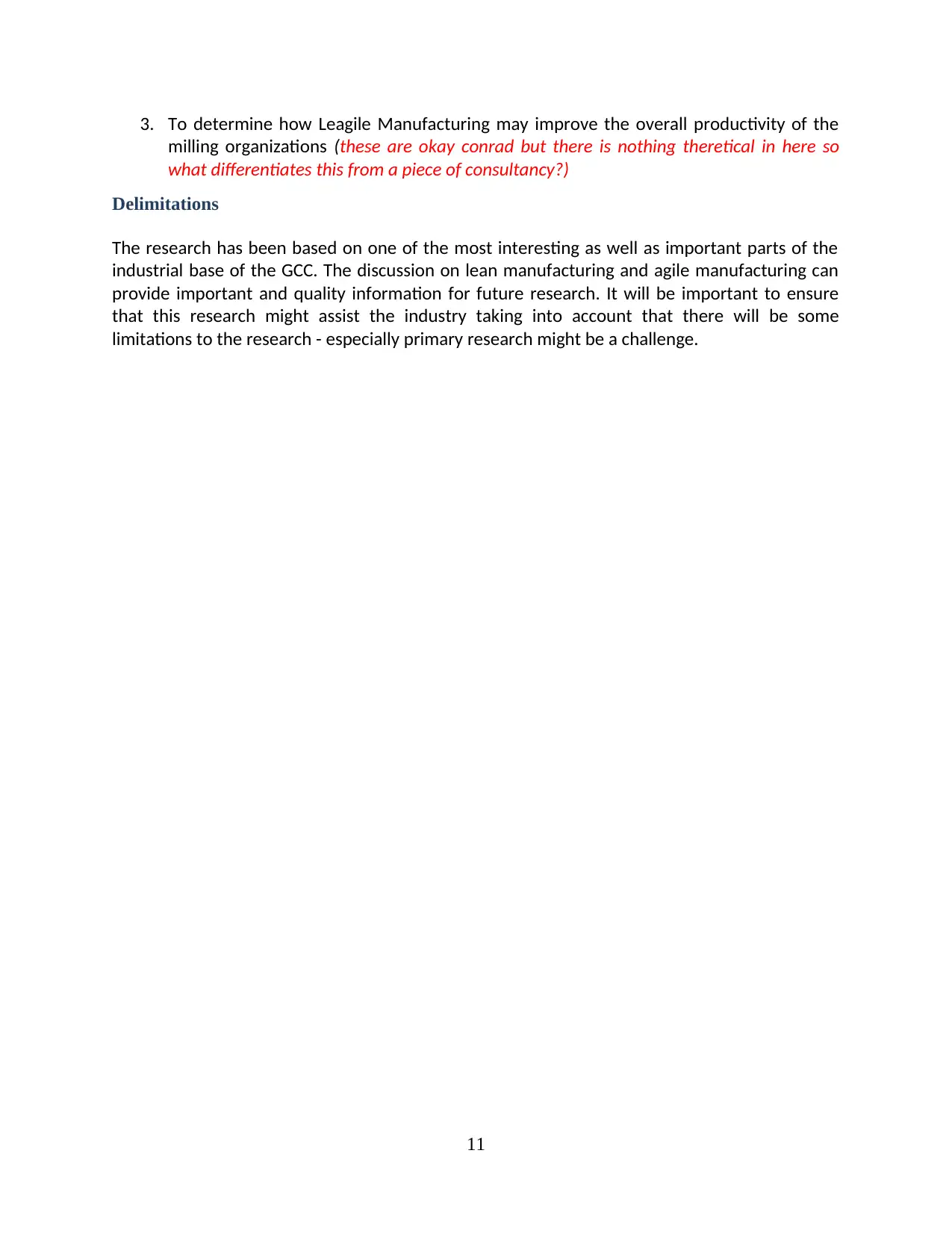
3. To determine how Leagile Manufacturing may improve the overall productivity of the
milling organizations (these are okay conrad but there is nothing theretical in here so
what differentiates this from a piece of consultancy?)
Delimitations
The research has been based on one of the most interesting as well as important parts of the
industrial base of the GCC. The discussion on lean manufacturing and agile manufacturing can
provide important and quality information for future research. It will be important to ensure
that this research might assist the industry taking into account that there will be some
limitations to the research - especially primary research might be a challenge.
11
milling organizations (these are okay conrad but there is nothing theretical in here so
what differentiates this from a piece of consultancy?)
Delimitations
The research has been based on one of the most interesting as well as important parts of the
industrial base of the GCC. The discussion on lean manufacturing and agile manufacturing can
provide important and quality information for future research. It will be important to ensure
that this research might assist the industry taking into account that there will be some
limitations to the research - especially primary research might be a challenge.
11
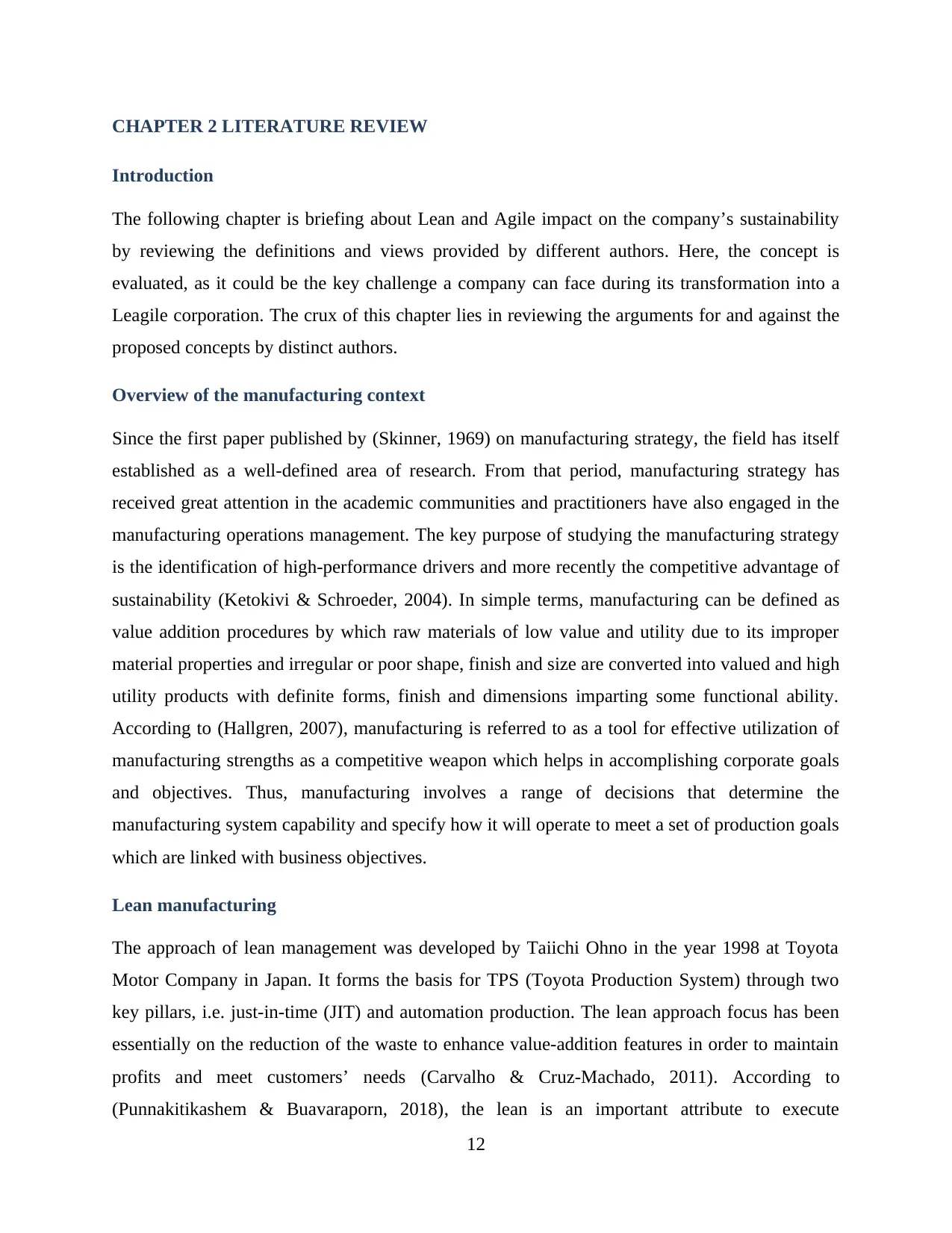
CHAPTER 2 LITERATURE REVIEW
Introduction
The following chapter is briefing about Lean and Agile impact on the company’s sustainability
by reviewing the definitions and views provided by different authors. Here, the concept is
evaluated, as it could be the key challenge a company can face during its transformation into a
Leagile corporation. The crux of this chapter lies in reviewing the arguments for and against the
proposed concepts by distinct authors.
Overview of the manufacturing context
Since the first paper published by (Skinner, 1969) on manufacturing strategy, the field has itself
established as a well-defined area of research. From that period, manufacturing strategy has
received great attention in the academic communities and practitioners have also engaged in the
manufacturing operations management. The key purpose of studying the manufacturing strategy
is the identification of high-performance drivers and more recently the competitive advantage of
sustainability (Ketokivi & Schroeder, 2004). In simple terms, manufacturing can be defined as
value addition procedures by which raw materials of low value and utility due to its improper
material properties and irregular or poor shape, finish and size are converted into valued and high
utility products with definite forms, finish and dimensions imparting some functional ability.
According to (Hallgren, 2007), manufacturing is referred to as a tool for effective utilization of
manufacturing strengths as a competitive weapon which helps in accomplishing corporate goals
and objectives. Thus, manufacturing involves a range of decisions that determine the
manufacturing system capability and specify how it will operate to meet a set of production goals
which are linked with business objectives.
Lean manufacturing
The approach of lean management was developed by Taiichi Ohno in the year 1998 at Toyota
Motor Company in Japan. It forms the basis for TPS (Toyota Production System) through two
key pillars, i.e. just-in-time (JIT) and automation production. The lean approach focus has been
essentially on the reduction of the waste to enhance value-addition features in order to maintain
profits and meet customers’ needs (Carvalho & Cruz-Machado, 2011). According to
(Punnakitikashem & Buavaraporn, 2018), the lean is an important attribute to execute
12
Introduction
The following chapter is briefing about Lean and Agile impact on the company’s sustainability
by reviewing the definitions and views provided by different authors. Here, the concept is
evaluated, as it could be the key challenge a company can face during its transformation into a
Leagile corporation. The crux of this chapter lies in reviewing the arguments for and against the
proposed concepts by distinct authors.
Overview of the manufacturing context
Since the first paper published by (Skinner, 1969) on manufacturing strategy, the field has itself
established as a well-defined area of research. From that period, manufacturing strategy has
received great attention in the academic communities and practitioners have also engaged in the
manufacturing operations management. The key purpose of studying the manufacturing strategy
is the identification of high-performance drivers and more recently the competitive advantage of
sustainability (Ketokivi & Schroeder, 2004). In simple terms, manufacturing can be defined as
value addition procedures by which raw materials of low value and utility due to its improper
material properties and irregular or poor shape, finish and size are converted into valued and high
utility products with definite forms, finish and dimensions imparting some functional ability.
According to (Hallgren, 2007), manufacturing is referred to as a tool for effective utilization of
manufacturing strengths as a competitive weapon which helps in accomplishing corporate goals
and objectives. Thus, manufacturing involves a range of decisions that determine the
manufacturing system capability and specify how it will operate to meet a set of production goals
which are linked with business objectives.
Lean manufacturing
The approach of lean management was developed by Taiichi Ohno in the year 1998 at Toyota
Motor Company in Japan. It forms the basis for TPS (Toyota Production System) through two
key pillars, i.e. just-in-time (JIT) and automation production. The lean approach focus has been
essentially on the reduction of the waste to enhance value-addition features in order to maintain
profits and meet customers’ needs (Carvalho & Cruz-Machado, 2011). According to
(Punnakitikashem & Buavaraporn, 2018), the lean is an important attribute to execute
12
⊘ This is a preview!⊘
Do you want full access?
Subscribe today to unlock all pages.

Trusted by 1+ million students worldwide
1 out of 28
Related Documents
Your All-in-One AI-Powered Toolkit for Academic Success.
+13062052269
info@desklib.com
Available 24*7 on WhatsApp / Email
![[object Object]](/_next/static/media/star-bottom.7253800d.svg)
Unlock your academic potential
Copyright © 2020–2025 A2Z Services. All Rights Reserved. Developed and managed by ZUCOL.





